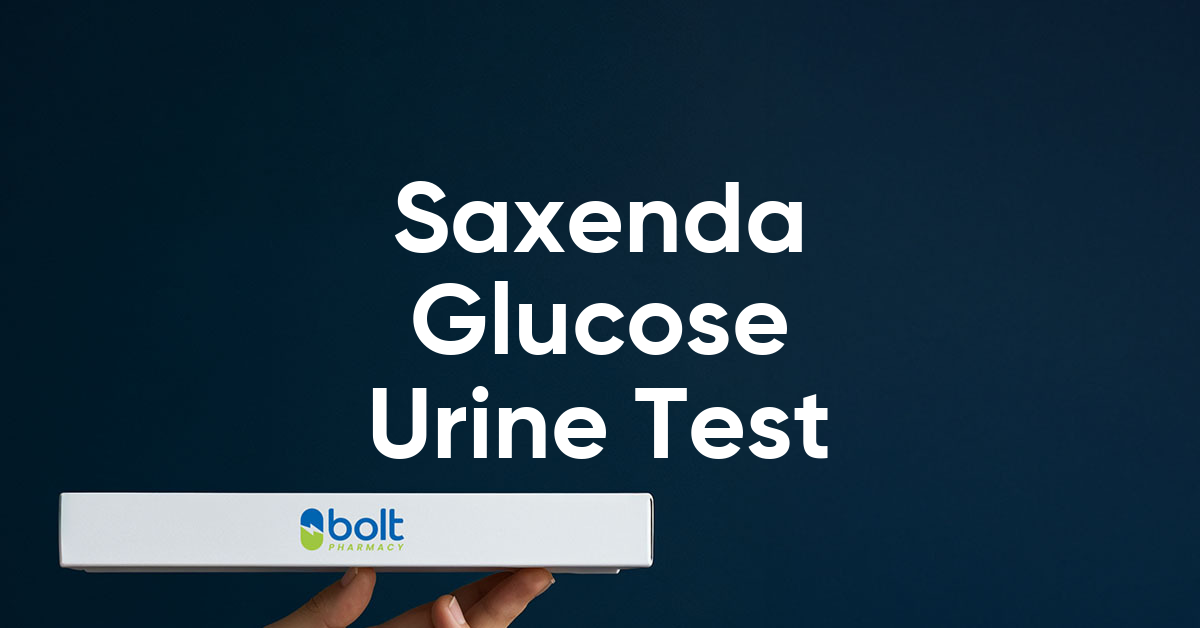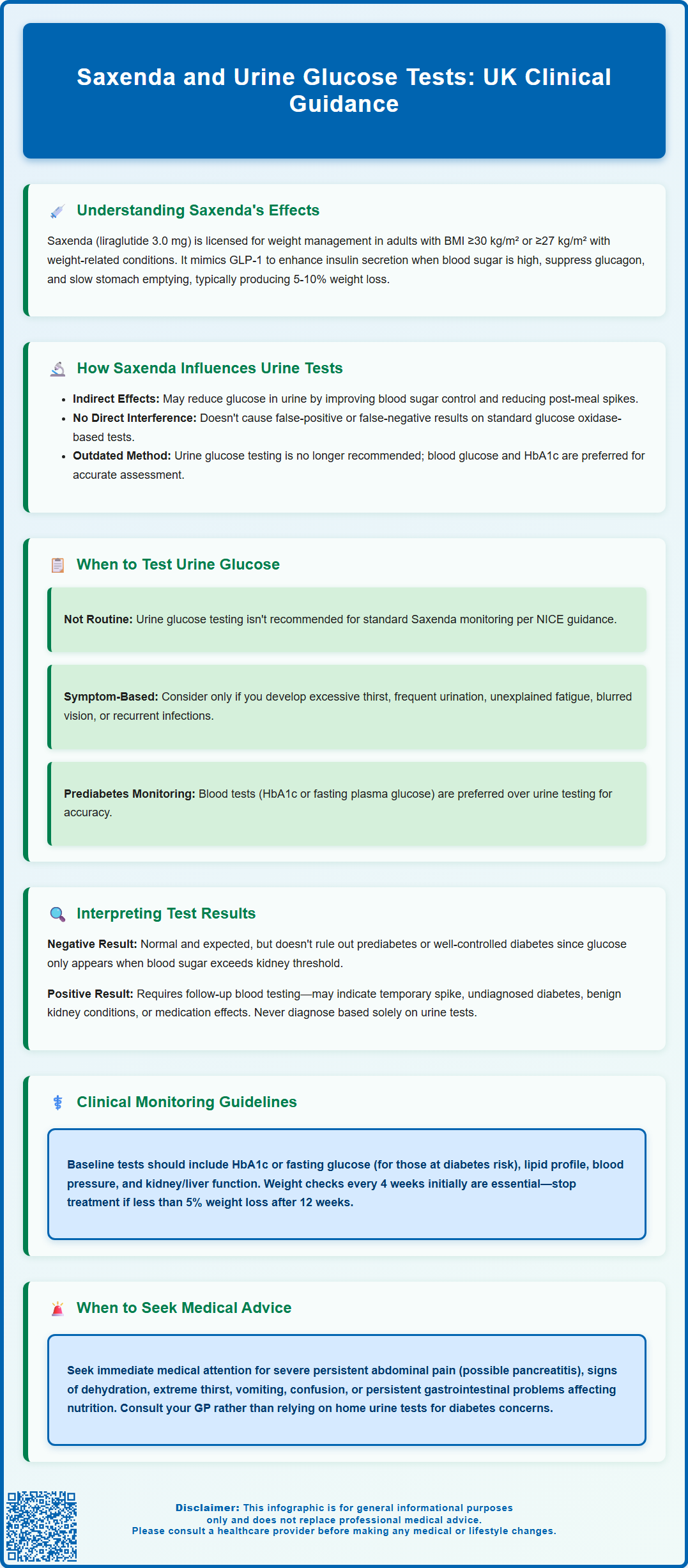Mounjaro®
Dual-agonist support that helps curb appetite, hunger, and cravings to drive substantial, sustained weight loss.
- ~22.5% average body weight loss
- Significant weight reduction
- Improves blood sugar levels
- Clinically proven weight loss

Saxenda (liraglutide 3.0 mg) is a GLP-1 receptor agonist licensed in the UK for weight management in adults with obesity or overweight with comorbidities. Whilst Saxenda influences glucose metabolism through its mechanism of action, questions often arise about whether it affects urine glucose test results. Understanding the relationship between Saxenda, glucose metabolism, and urine testing is important for patients and clinicians monitoring treatment safety and efficacy. This article examines how Saxenda may influence urine glucose tests, when such testing is appropriate, and the preferred methods for monitoring glucose levels during treatment.
Summary: Saxenda does not directly interfere with urine glucose tests but may reduce glycosuria by improving blood glucose control through its GLP-1 receptor agonist mechanism.
Saxenda (liraglutide 3.0 mg) is a glucagon-like peptide-1 (GLP-1) receptor agonist licensed in the UK for weight management in adults with a body mass index (BMI) of 30 kg/m² or greater, or 27 kg/m² or greater in the presence of weight-related comorbidities. Whilst Saxenda shares the same active ingredient as Victoza (liraglutide 1.8 mg), Saxenda itself is not licensed for glycaemic control. However, its mechanism of action inherently influences glucose metabolism.
Liraglutide works by mimicking the action of endogenous GLP-1, a hormone released from the gut in response to food intake. It enhances glucose-dependent insulin secretion from pancreatic beta cells, suppresses inappropriately elevated glucagon secretion, and slows gastric emptying. These combined effects lead to improved glycaemic control and reduced postprandial glucose excursions. In individuals without diabetes, Saxenda typically does not cause hypoglycaemia because insulin secretion is glucose-dependent—meaning insulin is only released when blood glucose levels are elevated. However, when used alongside sulfonylureas or insulin in people with diabetes, there is an increased risk of hypoglycaemia.
The weight loss achieved with Saxenda—averaging 5–10% of initial body weight in clinical trials (SCALE)—can further improve insulin sensitivity and glucose homeostasis, particularly in individuals with prediabetes or metabolic syndrome. It is important to note that whilst Saxenda influences glucose metabolism beneficially, it is not a substitute for diabetes medication in those with established type 2 diabetes. Patients with type 2 diabetes may use Saxenda for weight management, but their diabetes treatment may need adjustment to mitigate hypoglycaemia risk. Understanding these metabolic effects is essential when interpreting any glucose-related test results during Saxenda therapy.

Urine glucose testing detects the presence of glucose in urine, which normally occurs when blood glucose levels exceed the renal threshold—typically around 10 mmol/L, though this varies between individuals and can be lower during pregnancy or with age. In healthy physiology, the kidneys reabsorb virtually all filtered glucose, so urine should be glucose-free. Glycosuria (glucose in urine) traditionally indicates hyperglycaemia, though renal glycosuria (a benign condition where the renal threshold is abnormally low) can also cause positive results without elevated blood glucose.
Saxenda's influence on urine glucose tests is indirect and primarily relates to its effects on blood glucose levels. By improving glycaemic control and reducing postprandial glucose spikes, Saxenda may actually reduce the likelihood of glycosuria in individuals who previously had intermittent hyperglycaemia. For patients with prediabetes or undiagnosed glucose intolerance, initiating Saxenda alongside lifestyle modifications may normalise blood glucose levels sufficiently to eliminate previously positive urine glucose results.
Conversely, there is no evidence that Saxenda directly causes false-positive or false-negative urine glucose results. The medication does not interfere with the chemical reactions used in standard urine glucose test strips (typically glucose oxidase-based methods). However, clinicians should be aware that significant weight loss and improved insulin sensitivity achieved through Saxenda treatment may alter a patient's baseline glucose metabolism, potentially changing the clinical significance of urine glucose findings over time.
It's important to note that SGLT2 inhibitors (such as dapagliflozin, empagliflozin) cause glycosuria even with normal blood glucose levels, which can confound urine glucose interpretation if a patient is taking these medications.
It is crucial to emphasise that urine glucose testing is a relatively insensitive and non-specific screening tool. Modern diabetes care relies predominantly on blood glucose monitoring (capillary or venous) and HbA1c measurement, which provide far more accurate and clinically useful information about glycaemic control.
Routine urine glucose testing is not typically recommended as part of standard monitoring for patients taking Saxenda for weight management, particularly in those without diabetes. Current NICE guidance on obesity management does not advocate regular urine glucose screening in this population. However, there are specific clinical scenarios where urine glucose testing may be considered during Saxenda therapy.
Patients should consider urine glucose testing if they experience:
Symptoms suggestive of hyperglycaemia, including excessive thirst (polydipsia), frequent urination (polyuria), unexplained fatigue, or blurred vision
Unexplained weight loss beyond that expected from Saxenda therapy and dietary changes
Recurrent infections, particularly urinary tract infections or genital candidiasis, which may indicate undiagnosed diabetes
Family history of diabetes combined with other risk factors, prompting opportunistic screening
For individuals with prediabetes or impaired glucose tolerance at Saxenda initiation, periodic monitoring of glycaemic status is appropriate, though this should preferably involve HbA1c or fasting plasma glucose rather than urine testing. Some general practices may include urine glucose as part of routine health checks, but abnormal results should always be followed up with confirmatory blood tests using UK diagnostic thresholds (HbA1c ≥48 mmol/mol or fasting plasma glucose ≥7.0 mmol/L as per NICE/WHO criteria).
Pregnant women or those planning pregnancy should not use Saxenda, but if glycosuria is detected in any woman of childbearing age, pregnancy should be excluded and appropriate diabetes screening undertaken. Note that glycosuria can be physiological in pregnancy but still warrants assessment. Patients taking Saxenda alongside other medications that affect glucose metabolism (such as corticosteroids or certain antipsychotics) may warrant more vigilant glucose monitoring, though again, blood-based tests are preferred.
If you are taking Saxenda and have concerns about your glucose levels or diabetes risk, consult your GP or prescribing clinician rather than relying solely on home urine testing, which has significant limitations in sensitivity and specificity. If you develop severe symptoms such as extreme thirst, vomiting, drowsiness or confusion, seek urgent same-day medical advice.
Interpreting urine glucose results in patients taking Saxenda requires understanding both the limitations of the test and the clinical context. A negative urine glucose result (no glucose detected) is the expected finding in individuals with normal glucose metabolism and does not exclude prediabetes or even well-controlled diabetes, as glucose only appears in urine when blood levels exceed the renal threshold.
A positive urine glucose result during Saxenda treatment warrants further investigation but should not cause immediate alarm. Possible explanations include:
Transient postprandial hyperglycaemia: A large carbohydrate-rich meal may temporarily elevate blood glucose above the renal threshold, even in individuals without diabetes
Undiagnosed or inadequately controlled diabetes: Saxenda is not licensed for diabetes treatment, and persistent glycosuria may indicate the need for formal diabetes assessment
Renal glycosuria: A benign condition where glucose appears in urine despite normal blood glucose levels, due to reduced renal glucose reabsorption
Medication effects: Use of SGLT2 inhibitors (e.g., dapagliflozin, empagliflozin) causes glycosuria even with normal blood glucose levels
Medication interactions: Concurrent use of corticosteroids, thiazide diuretics, or other medications affecting glucose metabolism
Any positive urine glucose result should be followed by confirmatory blood testing, including fasting plasma glucose and/or HbA1c measurement. Do not attempt to diagnose or exclude diabetes based solely on urine testing. If you obtain a positive result, contact your GP within a few days to arrange appropriate blood tests and clinical review.
For patients with known diabetes (who may be using Saxenda for weight management), urine glucose testing is not recommended for routine monitoring. Blood glucose monitoring and HbA1c provide far superior information for treatment adjustment. However, persistent glycosuria despite apparently good blood glucose control may indicate the need to review the renal threshold or investigate for other causes.
False results can occasionally occur with certain urine test strips. High-dose vitamin C supplements can cause false-negative results with glucose oxidase-based tests, while oxidising contaminants (e.g., bleach) can cause false-positives. Always ensure samples are fresh and testing is performed according to manufacturer instructions.
Comprehensive clinical monitoring during Saxenda treatment should focus on evidence-based parameters rather than routine urine glucose testing. NICE guidance on obesity management recommends regular assessment of weight loss progress, tolerability, and cardiovascular risk factors, with consideration of metabolic parameters in at-risk individuals.
Baseline assessments before initiating Saxenda should include:
HbA1c or fasting plasma glucose in patients with risk factors for diabetes (obesity, family history, ethnicity, previous gestational diabetes, polycystic ovary syndrome)
Lipid profile and blood pressure measurement
Renal and hepatic function tests—use of Saxenda is not recommended in severe renal or hepatic impairment due to limited data, though no dose adjustment is needed for mild/moderate impairment
Ongoing monitoring should include weight and tolerability assessment at regular intervals (typically 4-weekly initially). For patients with prediabetes or metabolic syndrome at baseline, repeat HbA1c testing at 6–12 months is appropriate to assess whether glucose metabolism has improved with weight loss or whether progression to diabetes has occurred.
Blood glucose monitoring is generally not required in individuals without diabetes taking Saxenda, unless symptoms of hypo- or hyperglycaemia develop. However, patients with prediabetes should be counselled on diabetes prevention and the importance of ongoing metabolic surveillance. Those with established type 2 diabetes using Saxenda for weight management should have appropriate blood glucose monitoring as per standard diabetes care protocols.
When to seek medical advice:
Symptoms of hyperglycaemia (excessive thirst, frequent urination, fatigue)
Symptoms of hypoglycaemia (tremor, sweating, confusion)—rare with Saxenda alone but possible if combined with other glucose-lowering medications
Severe, persistent abdominal pain with or without vomiting (consider pancreatitis)
Right upper quadrant pain or fever (possible gallstones)
Signs of dehydration
Persistent gastrointestinal symptoms affecting nutritional intake
Inadequate weight loss response after 12 weeks (less than 5% body weight loss)—the MHRA/EMC SmPC states treatment should be discontinued if this target is not met
Patients should be empowered to discuss any concerns about glucose metabolism with their healthcare team, ensuring that appropriate, evidence-based testing is undertaken rather than relying on less reliable urine-based screening methods. Any suspected side effects should be reported via the MHRA Yellow Card Scheme.
No, Saxenda does not directly interfere with urine glucose test strips or cause false results. However, by improving blood glucose control, it may reduce glycosuria in individuals who previously had intermittent hyperglycaemia.
Routine urine glucose testing is not typically recommended during Saxenda treatment. Blood-based tests such as HbA1c or fasting plasma glucose provide more accurate assessment of glycaemic control and are preferred by UK clinicians.
Contact your GP within a few days to arrange confirmatory blood tests (fasting plasma glucose and/or HbA1c). Do not attempt to diagnose or exclude diabetes based solely on urine testing, as it has significant limitations in sensitivity and specificity.
The health-related content published on this site is based on credible scientific sources and is periodically reviewed to ensure accuracy and relevance. Although we aim to reflect the most current medical knowledge, the material is meant for general education and awareness only.
The information on this site is not a substitute for professional medical advice. For any health concerns, please speak with a qualified medical professional. By using this information, you acknowledge responsibility for any decisions made and understand we are not liable for any consequences that may result.
Lorem ipsum dolor sit amet, consectetur adipiscing elit, sed do eiusmod tempor incididunt ut labore et dolore magna aliqua. Ut enim ad minim veniam, quis nostrud exercitation ullamco laboris nisi ut aliquip ex ea commodo consequat. Duis aute irure dolor in reprehenderit in voluptate velit esse cillum dolore eu fugiat nulla pariatur.
Block quote
Ordered list
Unordered list
Bold text
Emphasis
Superscript
Subscript